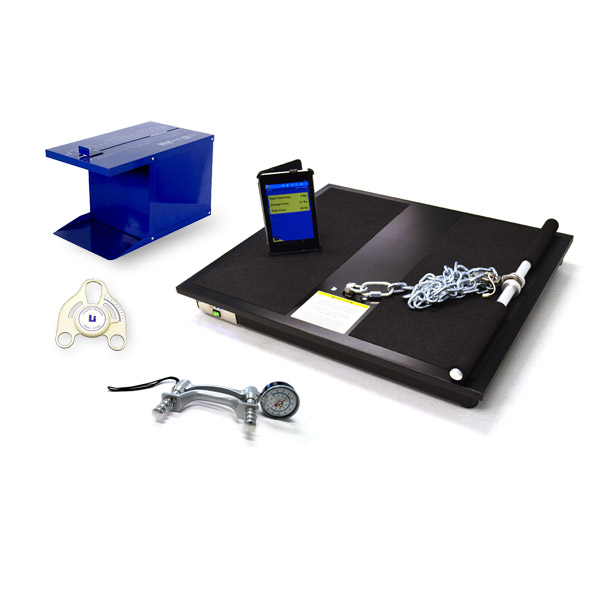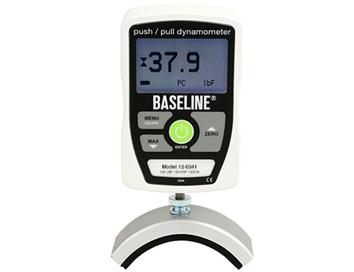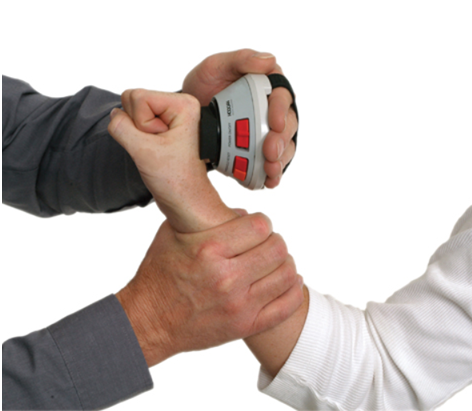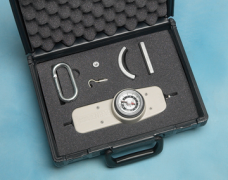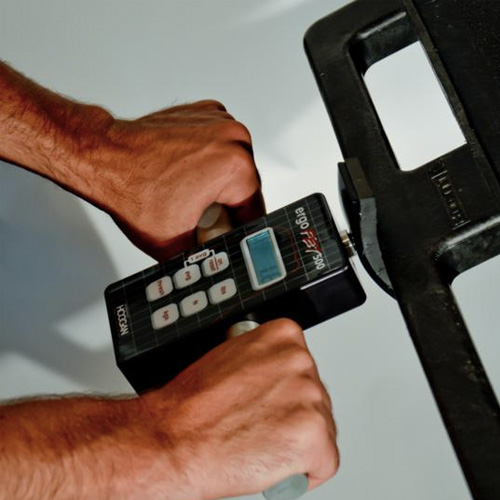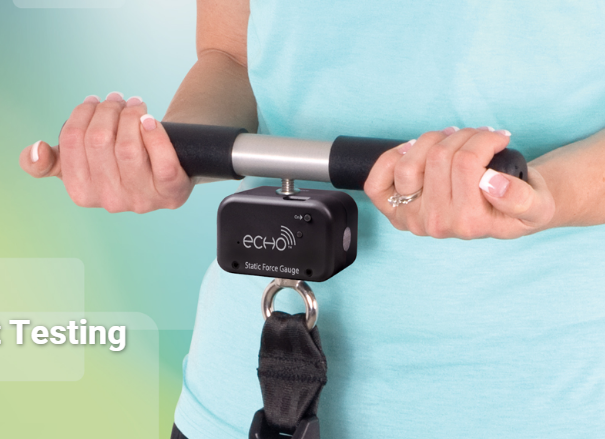JACKSON STRENGTH EVALUATION SYSTEM Model 32728 DETAILS The Jackson Strength Evaluation System was developed by Dr. Andrew Jackson at the University of Houston. The system is widely used by rehabilitation professionals to monitor progress in recovery from injury and by industrial testing specialists to assess the ability of job applicants to perform physically demanding work tasks. The system features an electronic load cell for accurate and reliable measurements of isometric strength and a Nexus tablet that interfaces with the load cell via Bluetooth. The system is designed to meet the needs of Jackson lift, torso and pull strength test protocols, and the lift tasks of the National Institute of Occupational Safety and Health (NIOSH). The system comes complete with detailed instructions for the recommended strength tests and offers validated, standardized test protocols and normative data. It is lightweight and compact making it highly portable. The components of this system can be purchased individually. WHY SHOULD I USE ISOMETRIC STRENGTH TESTING? Isometric strength is defined as the maximum force that a muscle group can exert without movement. Tests of isometric strength are easy to perform as they require only a single, maximal contraction. Bottom line: Isometric strength testing is inexpensive and flexible. Isometric strength tests are often favored because of the ease of use and the quick manner in which the maximal capacity of a muscle group can be determined. By creating the proper test environment, many different types of strength can be evaluated. AVAILABLE TESTS Arm Lift Leg Lift (requires V-Grip Bar, Model 32628VB) Shoulder Lift Seated Torso Pull (requires Jackson Torso Kit, Model 32728TK) WHY THE JACKSON SYSTEM? Pre-employment Testing Evaluation and Rehabilitation of Patients Evaluation and Training of Athletes Evaluation of Physical Fitness Employee Placement to Increase Productivity JACKSON STRENGTH EVALUATION SYSTEM WITH 220V/50HZ POWER SUPPLY Model 32728*C V-GRIP HANDLEBAR Model 32628VB
JACKSON STRENGTH EVALUATION SYSTEM Model 32728 DETAILS The Jackson Strength Evaluation System was developed by Dr. Andrew Jackson at the University of Houston. The system is widely used by rehabilitation professionals to monitor progress in recovery from injury and by industrial testing specialists to assess the ability of job applicants to perform physically demanding work tasks. The system features an electronic load cell for accurate and reliable measurements of isometric strength and a Nexus tablet that interfaces with the load cell via Bluetooth. The system is designed to meet the needs of Jackson lift, torso and pull strength test protocols, and the lift tasks of the National Institute of Occupational Safety and Health (NIOSH). The system comes complete with detailed instructions for the recommended strength tests and offers validated, standardized test protocols and normative data. It is lightweight and compact making it highly portable. The components of this system can be purchased individually. WHY SHOULD I USE ISOMETRIC STRENGTH TESTING? Isometric strength is defined as the maximum force that a muscle group can exert without movement. Tests of isometric strength are easy to perform as they require only a single, maximal contraction. Bottom line: Isometric strength testing is inexpensive and flexible. Isometric strength tests are often favored because of the ease of use and the quick manner in which the maximal capacity of a muscle group can be determined. By creating the proper test environment, many different types of strength can be evaluated. AVAILABLE TESTS Arm Lift Leg Lift (requires V-Grip Bar, Model 32628VB) Shoulder Lift Seated Torso Pull (requires Jackson Torso Kit, Model 32728TK) WHY THE JACKSON SYSTEM? Pre-employment Testing Evaluation and Rehabilitation of Patients Evaluation and Training of Athletes Evaluation of Physical Fitness Employee Placement to Increase Productivity JACKSON STRENGTH EVALUATION SYSTEM WITH 220V/50HZ POWER SUPPLY Model 32728*C V-GRIP HANDLEBAR Model 32628VB
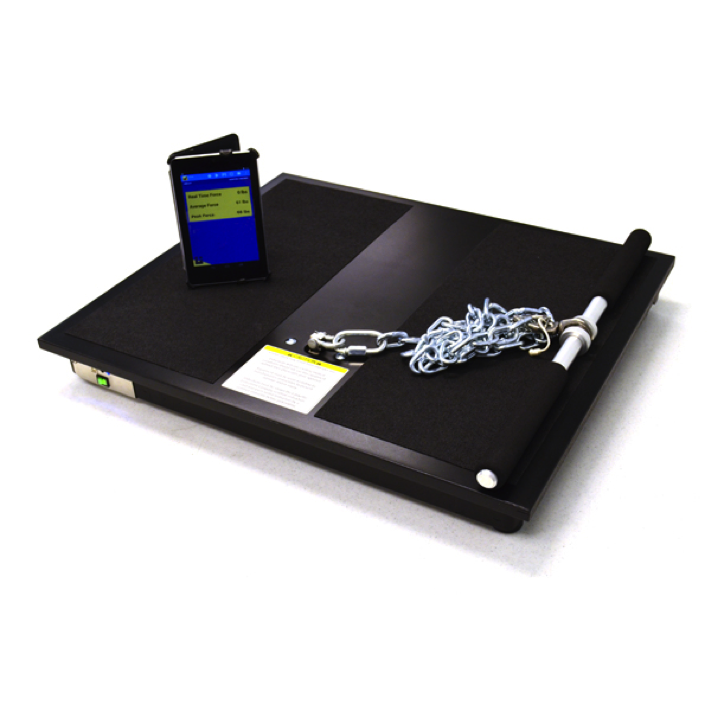
JACKSON杰克逊力量评估系统
JACKSON杰克逊力量评估系统( JACKSON STRENGTH EVALUATION SYSTEM)由休斯顿大学的安德鲁.杰克逊博士(Dr. Andrew Jackson)开发。该系统被康复专业人员广泛用于评估监测受伤后康复治疗的进展,以及职业康复评估专业人员用于评估执行体力劳动任务求职者的工作能力。
该系统具有电子称重传感器,Nexus平板电脑通过蓝牙与称重传感器连接,可准确可靠地测量等距的力量强度。JACKSON杰克逊力量评估系统旨在满足评估测试提拉力,JACKSON杰克逊躯干测试和拉力测试的协议的标准,符合美国国家职业安全与健康研究所(National Institute of Occupational Safety and Health ,NIOSH),关于提举(搬运)工作的技术分析指南。
JACKSON杰克逊力量评估系统,附有指导性的强度测试详细说明,以及经过验证的标准化测试协议和规范数据。该系统重量轻,结构紧凑,便于携带。JACKSON杰克逊力量评估系统该系统的选配组件可以根据需要另行单独购买。
为什么我们要使用等距强度测试?
等距力是指肌肉群在不运动的情况下所能发挥的最大力量。等距强度测试很容易进行,因为只需要做一次最大的肌肉收缩就可以。
等距强度测试既经济又灵活。等距强度测试因为易于使用和能使用简单快速的方式,准确测定身体其中一个肌肉群的最大力量,所以备受青睐。我们通过创建不同的测试环境和要求,等距强度测试可以评估多种不同类型的肌肉力量强度。
可以选用的测试项目
- 手臂举起
- 抬腿(需要v型握杆,型号32628VB)
- 抬肩
- 坐位体躯干拉伸(需要Jackson躯干套件,型号32728TK)
JACKSON力量评估系统的主要用途
- 就业前测试
- 职业康复评估——工作能力评估
- 职业康复评估——体力劳动能力评估
- 运动员的评价和训练
- 体能评估
- 员工安置,提高生产力
JACKSON杰克逊力量评估系统选配组件
- JACKSON杰克逊力量评估系统v型握杆(把手),型号:32628VB
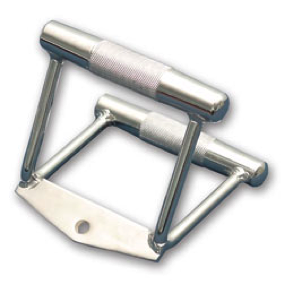
- JACKSON杰克逊力量评估系统适配电源,220伏/50赫兹,型号:32728*C
| 32728 | JACKSON杰克逊力量评估系统 | 电邮询价 |
| 32728*C | JACKSON杰克逊力量评估系统适配电源,220伏/50赫兹 | 电邮询价 |
| 32628VB | JACKSON杰克逊力量评估系统v型握杆(把手) | 电邮询价 |
JACKSON STRENGTH EVALUATION SYSTEM Model 32728 DETAILS The Jackson Strength Evaluation System was developed by Dr. Andrew Jackson at the University of Houston. The system is widely used by rehabilitation professionals to monitor progress in recovery from injury and by industrial testing specialists to assess the ability of job applicants to perform physically demanding work tasks. The system features an electronic load cell for accurate and reliable measurements of isometric strength and a Nexus tablet that interfaces with the load cell via Bluetooth. The system is designed to meet the needs of Jackson lift, torso and pull strength test protocols, and the lift tasks of the National Institute of Occupational Safety and Health (NIOSH). The system comes complete with detailed instructions for the recommended strength tests and offers validated, standardized test protocols and normative data. It is lightweight and compact making it highly portable. The components of this system can be purchased individually. WHY SHOULD I USE ISOMETRIC STRENGTH TESTING? Isometric strength is defined as the maximum force that a muscle group can exert without movement. Tests of isometric strength are easy to perform as they require only a single, maximal contraction. Bottom line: Isometric strength testing is inexpensive and flexible. Isometric strength tests are often favored because of the ease of use and the quick manner in which the maximal capacity of a muscle group can be determined. By creating the proper test environment, many different types of strength can be evaluated. AVAILABLE TESTS Arm Lift Leg Lift (requires V-Grip Bar, Model 32628VB) Shoulder Lift Seated Torso Pull (requires Jackson Torso Kit, Model 32728TK) WHY THE JACKSON SYSTEM? Pre-employment Testing Evaluation and Rehabilitation of Patients Evaluation and Training of Athletes Evaluation of Physical Fitness Employee Placement to Increase Productivity JACKSON STRENGTH EVALUATION SYSTEM WITH 220V/50HZ POWER SUPPLY Model 32728*C V-GRIP HANDLEBAR Model 32628VB
JACKSON STRENGTH EVALUATION SYSTEM Model 32728 DETAILS The Jackson Strength Evaluation System was developed by Dr. Andrew Jackson at the University of Houston. The system is widely used by rehabilitation professionals to monitor progress in recovery from injury and by industrial testing specialists to assess the ability of job applicants to perform physically demanding work tasks. The system features an electronic load cell for accurate and reliable measurements of isometric strength and a Nexus tablet that interfaces with the load cell via Bluetooth. The system is designed to meet the needs of Jackson lift, torso and pull strength test protocols, and the lift tasks of the National Institute of Occupational Safety and Health (NIOSH). The system comes complete with detailed instructions for the recommended strength tests and offers validated, standardized test protocols and normative data. It is lightweight and compact making it highly portable. The components of this system can be purchased individually. WHY SHOULD I USE ISOMETRIC STRENGTH TESTING? Isometric strength is defined as the maximum force that a muscle group can exert without movement. Tests of isometric strength are easy to perform as they require only a single, maximal contraction. Bottom line: Isometric strength testing is inexpensive and flexible. Isometric strength tests are often favored because of the ease of use and the quick manner in which the maximal capacity of a muscle group can be determined. By creating the proper test environment, many different types of strength can be evaluated. AVAILABLE TESTS Arm Lift Leg Lift (requires V-Grip Bar, Model 32628VB) Shoulder Lift Seated Torso Pull (requires Jackson Torso Kit, Model 32728TK) WHY THE JACKSON SYSTEM? Pre-employment Testing Evaluation and Rehabilitation of Patients Evaluation and Training of Athletes Evaluation of Physical Fitness Employee Placement to Increase Productivity JACKSON STRENGTH EVALUATION SYSTEM WITH 220V/50HZ POWER SUPPLY Model 32728*C V-GRIP HANDLEBAR Model 32628VB
JACKSON STRENGTH EVALUATION SYSTEM Model 32728 DETAILS The Jackson Strength Evaluation System was developed by Dr. Andrew Jackson at the University of Houston. The system is widely used by rehabilitation professionals to monitor progress in recovery from injury and by industrial testing specialists to assess the ability of job applicants to perform physically demanding work tasks. The system features an electronic load cell for accurate and reliable measurements of isometric strength and a Nexus tablet that interfaces with the load cell via Bluetooth. The system is designed to meet the needs of Jackson lift, torso and pull strength test protocols, and the lift tasks of the National Institute of Occupational Safety and Health (NIOSH). The system comes complete with detailed instructions for the recommended strength tests and offers validated, standardized test protocols and normative data. It is lightweight and compact making it highly portable. The components of this system can be purchased individually. WHY SHOULD I USE ISOMETRIC STRENGTH TESTING? Isometric strength is defined as the maximum force that a muscle group can exert without movement. Tests of isometric strength are easy to perform as they require only a single, maximal contraction. Bottom line: Isometric strength testing is inexpensive and flexible. Isometric strength tests are often favored because of the ease of use and the quick manner in which the maximal capacity of a muscle group can be determined. By creating the proper test environment, many different types of strength can be evaluated. AVAILABLE TESTS Arm Lift Leg Lift (requires V-Grip Bar, Model 32628VB) Shoulder Lift Seated Torso Pull (requires Jackson Torso Kit, Model 32728TK) WHY THE JACKSON SYSTEM? Pre-employment Testing Evaluation and Rehabilitation of Patients Evaluation and Training of Athletes Evaluation of Physical Fitness Employee Placement to Increase Productivity JACKSON STRENGTH EVALUATION SYSTEM WITH 220V/50HZ POWER SUPPLY Model 32728*C V-GRIP HANDLEBAR Model 32628VB
JACKSON STRENGTH EVALUATION SYSTEM Model 32728 DETAILS The Jackson Strength Evaluation System was developed by Dr. Andrew Jackson at the University of Houston. The system is widely used by rehabilitation professionals to monitor progress in recovery from injury and by industrial testing specialists to assess the ability of job applicants to perform physically demanding work tasks. The system features an electronic load cell for accurate and reliable measurements of isometric strength and a Nexus tablet that interfaces with the load cell via Bluetooth. The system is designed to meet the needs of Jackson lift, torso and pull strength test protocols, and the lift tasks of the National Institute of Occupational Safety and Health (NIOSH). The system comes complete with detailed instructions for the recommended strength tests and offers validated, standardized test protocols and normative data. It is lightweight and compact making it highly portable. The components of this system can be purchased individually. WHY SHOULD I USE ISOMETRIC STRENGTH TESTING? Isometric strength is defined as the maximum force that a muscle group can exert without movement. Tests of isometric strength are easy to perform as they require only a single, maximal contraction. Bottom line: Isometric strength testing is inexpensive and flexible. Isometric strength tests are often favored because of the ease of use and the quick manner in which the maximal capacity of a muscle group can be determined. By creating the proper test environment, many different types of strength can be evaluated. AVAILABLE TESTS Arm Lift Leg Lift (requires V-Grip Bar, Model 32628VB) Shoulder Lift Seated Torso Pull (requires Jackson Torso Kit, Model 32728TK) WHY THE JACKSON SYSTEM? Pre-employment Testing Evaluation and Rehabilitation of Patients Evaluation and Training of Athletes Evaluation of Physical Fitness Employee Placement to Increase Productivity JACKSON STRENGTH EVALUATION SYSTEM WITH 220V/50HZ POWER SUPPLY Model 32728*C V-GRIP HANDLEBAR Model 32628VB
JACKSON STRENGTH EVALUATION SYSTEM Model 32728 DETAILS The Jackson Strength Evaluation System was developed by Dr. Andrew Jackson at the University of Houston. The system is widely used by rehabilitation professionals to monitor progress in recovery from injury and by industrial testing specialists to assess the ability of job applicants to perform physically demanding work tasks. The system features an electronic load cell for accurate and reliable measurements of isometric strength and a Nexus tablet that interfaces with the load cell via Bluetooth. The system is designed to meet the needs of Jackson lift, torso and pull strength test protocols, and the lift tasks of the National Institute of Occupational Safety and Health (NIOSH). The system comes complete with detailed instructions for the recommended strength tests and offers validated, standardized test protocols and normative data. It is lightweight and compact making it highly portable. The components of this system can be purchased individually. WHY SHOULD I USE ISOMETRIC STRENGTH TESTING? Isometric strength is defined as the maximum force that a muscle group can exert without movement. Tests of isometric strength are easy to perform as they require only a single, maximal contraction. Bottom line: Isometric strength testing is inexpensive and flexible. Isometric strength tests are often favored because of the ease of use and the quick manner in which the maximal capacity of a muscle group can be determined. By creating the proper test environment, many different types of strength can be evaluated. AVAILABLE TESTS Arm Lift Leg Lift (requires V-Grip Bar, Model 32628VB) Shoulder Lift Seated Torso Pull (requires Jackson Torso Kit, Model 32728TK) WHY THE JACKSON SYSTEM? Pre-employment Testing Evaluation and Rehabilitation of Patients Evaluation and Training of Athletes Evaluation of Physical Fitness Employee Placement to Increase Productivity JACKSON STRENGTH EVALUATION SYSTEM WITH 220V/50HZ POWER SUPPLY Model 32728*C V-GRIP HANDLEBAR Model 32628VB
JACKSON STRENGTH EVALUATION SYSTEM Model 32728 DETAILS The Jackson Strength Evaluation System was developed by Dr. Andrew Jackson at the University of Houston. The system is widely used by rehabilitation professionals to monitor progress in recovery from injury and by industrial testing specialists to assess the ability of job applicants to perform physically demanding work tasks. The system features an electronic load cell for accurate and reliable measurements of isometric strength and a Nexus tablet that interfaces with the load cell via Bluetooth. The system is designed to meet the needs of Jackson lift, torso and pull strength test protocols, and the lift tasks of the National Institute of Occupational Safety and Health (NIOSH). The system comes complete with detailed instructions for the recommended strength tests and offers validated, standardized test protocols and normative data. It is lightweight and compact making it highly portable. The components of this system can be purchased individually. WHY SHOULD I USE ISOMETRIC STRENGTH TESTING? Isometric strength is defined as the maximum force that a muscle group can exert without movement. Tests of isometric strength are easy to perform as they require only a single, maximal contraction. Bottom line: Isometric strength testing is inexpensive and flexible. Isometric strength tests are often favored because of the ease of use and the quick manner in which the maximal capacity of a muscle group can be determined. By creating the proper test environment, many different types of strength can be evaluated. AVAILABLE TESTS Arm Lift Leg Lift (requires V-Grip Bar, Model 32628VB) Shoulder Lift Seated Torso Pull (requires Jackson Torso Kit, Model 32728TK) WHY THE JACKSON SYSTEM? Pre-employment Testing Evaluation and Rehabilitation of Patients Evaluation and Training of Athletes Evaluation of Physical Fitness Employee Placement to Increase Productivity JACKSON STRENGTH EVALUATION SYSTEM WITH 220V/50HZ POWER SUPPLY Model 32728*C V-GRIP HANDLEBAR Model 32628VB
JACKSON STRENGTH EVALUATION SYSTEM Model 32728 DETAILS The Jackson Strength Evaluation System was developed by Dr. Andrew Jackson at the University of Houston. The system is widely used by rehabilitation professionals to monitor progress in recovery from injury and by industrial testing specialists to assess the ability of job applicants to perform physically demanding work tasks. The system features an electronic load cell for accurate and reliable measurements of isometric strength and a Nexus tablet that interfaces with the load cell via Bluetooth. The system is designed to meet the needs of Jackson lift, torso and pull strength test protocols, and the lift tasks of the National Institute of Occupational Safety and Health (NIOSH). The system comes complete with detailed instructions for the recommended strength tests and offers validated, standardized test protocols and normative data. It is lightweight and compact making it highly portable. The components of this system can be purchased individually. WHY SHOULD I USE ISOMETRIC STRENGTH TESTING? Isometric strength is defined as the maximum force that a muscle group can exert without movement. Tests of isometric strength are easy to perform as they require only a single, maximal contraction. Bottom line: Isometric strength testing is inexpensive and flexible. Isometric strength tests are often favored because of the ease of use and the quick manner in which the maximal capacity of a muscle group can be determined. By creating the proper test environment, many different types of strength can be evaluated. AVAILABLE TESTS Arm Lift Leg Lift (requires V-Grip Bar, Model 32628VB) Shoulder Lift Seated Torso Pull (requires Jackson Torso Kit, Model 32728TK) WHY THE JACKSON SYSTEM? Pre-employment Testing Evaluation and Rehabilitation of Patients Evaluation and Training of Athletes Evaluation of Physical Fitness Employee Placement to Increase Productivity JACKSON STRENGTH EVALUATION SYSTEM WITH 220V/50HZ POWER SUPPLY Model 32728*C V-GRIP HANDLEBAR Model 32628VB
JACKSON STRENGTH EVALUATION SYSTEM Model 32728 DETAILS The Jackson Strength Evaluation System was developed by Dr. Andrew Jackson at the University of Houston. The system is widely used by rehabilitation professionals to monitor progress in recovery from injury and by industrial testing specialists to assess the ability of job applicants to perform physically demanding work tasks. The system features an electronic load cell for accurate and reliable measurements of isometric strength and a Nexus tablet that interfaces with the load cell via Bluetooth. The system is designed to meet the needs of Jackson lift, torso and pull strength test protocols, and the lift tasks of the National Institute of Occupational Safety and Health (NIOSH). The system comes complete with detailed instructions for the recommended strength tests and offers validated, standardized test protocols and normative data. It is lightweight and compact making it highly portable. The components of this system can be purchased individually. WHY SHOULD I USE ISOMETRIC STRENGTH TESTING? Isometric strength is defined as the maximum force that a muscle group can exert without movement. Tests of isometric strength are easy to perform as they require only a single, maximal contraction. Bottom line: Isometric strength testing is inexpensive and flexible. Isometric strength tests are often favored because of the ease of use and the quick manner in which the maximal capacity of a muscle group can be determined. By creating the proper test environment, many different types of strength can be evaluated. AVAILABLE TESTS Arm Lift Leg Lift (requires V-Grip Bar, Model 32628VB) Shoulder Lift Seated Torso Pull (requires Jackson Torso Kit, Model 32728TK) WHY THE JACKSON SYSTEM? Pre-employment Testing Evaluation and Rehabilitation of Patients Evaluation and Training of Athletes Evaluation of Physical Fitness Employee Placement to Increase Productivity JACKSON STRENGTH EVALUATION SYSTEM WITH 220V/50HZ POWER SUPPLY Model 32728*C V-GRIP HANDLEBAR Model 32628VB
JACKSON STRENGTH EVALUATION SYSTEM Model 32728 DETAILS The Jackson Strength Evaluation System was developed by Dr. Andrew Jackson at the University of Houston. The system is widely used by rehabilitation professionals to monitor progress in recovery from injury and by industrial testing specialists to assess the ability of job applicants to perform physically demanding work tasks. The system features an electronic load cell for accurate and reliable measurements of isometric strength and a Nexus tablet that interfaces with the load cell via Bluetooth. The system is designed to meet the needs of Jackson lift, torso and pull strength test protocols, and the lift tasks of the National Institute of Occupational Safety and Health (NIOSH). The system comes complete with detailed instructions for the recommended strength tests and offers validated, standardized test protocols and normative data. It is lightweight and compact making it highly portable. The components of this system can be purchased individually. WHY SHOULD I USE ISOMETRIC STRENGTH TESTING? Isometric strength is defined as the maximum force that a muscle group can exert without movement. Tests of isometric strength are easy to perform as they require only a single, maximal contraction. Bottom line: Isometric strength testing is inexpensive and flexible. Isometric strength tests are often favored because of the ease of use and the quick manner in which the maximal capacity of a muscle group can be determined. By creating the proper test environment, many different types of strength can be evaluated. AVAILABLE TESTS Arm Lift Leg Lift (requires V-Grip Bar, Model 32628VB) Shoulder Lift Seated Torso Pull (requires Jackson Torso Kit, Model 32728TK) WHY THE JACKSON SYSTEM? Pre-employment Testing Evaluation and Rehabilitation of Patients Evaluation and Training of Athletes Evaluation of Physical Fitness Employee Placement to Increase Productivity JACKSON STRENGTH EVALUATION SYSTEM WITH 220V/50HZ POWER SUPPLY Model 32728*C V-GRIP HANDLEBAR Model 32628VB
JACKSON STRENGTH EVALUATION SYSTEM Model 32728 DETAILS The Jackson Strength Evaluation System was developed by Dr. Andrew Jackson at the University of Houston. The system is widely used by rehabilitation professionals to monitor progress in recovery from injury and by industrial testing specialists to assess the ability of job applicants to perform physically demanding work tasks. The system features an electronic load cell for accurate and reliable measurements of isometric strength and a Nexus tablet that interfaces with the load cell via Bluetooth. The system is designed to meet the needs of Jackson lift, torso and pull strength test protocols, and the lift tasks of the National Institute of Occupational Safety and Health (NIOSH). The system comes complete with detailed instructions for the recommended strength tests and offers validated, standardized test protocols and normative data. It is lightweight and compact making it highly portable. The components of this system can be purchased individually. WHY SHOULD I USE ISOMETRIC STRENGTH TESTING? Isometric strength is defined as the maximum force that a muscle group can exert without movement. Tests of isometric strength are easy to perform as they require only a single, maximal contraction. Bottom line: Isometric strength testing is inexpensive and flexible. Isometric strength tests are often favored because of the ease of use and the quick manner in which the maximal capacity of a muscle group can be determined. By creating the proper test environment, many different types of strength can be evaluated. AVAILABLE TESTS Arm Lift Leg Lift (requires V-Grip Bar, Model 32628VB) Shoulder Lift Seated Torso Pull (requires Jackson Torso Kit, Model 32728TK) WHY THE JACKSON SYSTEM? Pre-employment Testing Evaluation and Rehabilitation of Patients Evaluation and Training of Athletes Evaluation of Physical Fitness Employee Placement to Increase Productivity JACKSON STRENGTH EVALUATION SYSTEM WITH 220V/50HZ POWER SUPPLY Model 32728*C V-GRIP HANDLEBAR Model 32628VB
JACKSON STRENGTH EVALUATION SYSTEM Model 32728 DETAILS The Jackson Strength Evaluation System was developed by Dr. Andrew Jackson at the University of Houston. The system is widely used by rehabilitation professionals to monitor progress in recovery from injury and by industrial testing specialists to assess the ability of job applicants to perform physically demanding work tasks. The system features an electronic load cell for accurate and reliable measurements of isometric strength and a Nexus tablet that interfaces with the load cell via Bluetooth. The system is designed to meet the needs of Jackson lift, torso and pull strength test protocols, and the lift tasks of the National Institute of Occupational Safety and Health (NIOSH). The system comes complete with detailed instructions for the recommended strength tests and offers validated, standardized test protocols and normative data. It is lightweight and compact making it highly portable. The components of this system can be purchased individually. WHY SHOULD I USE ISOMETRIC STRENGTH TESTING? Isometric strength is defined as the maximum force that a muscle group can exert without movement. Tests of isometric strength are easy to perform as they require only a single, maximal contraction. Bottom line: Isometric strength testing is inexpensive and flexible. Isometric strength tests are often favored because of the ease of use and the quick manner in which the maximal capacity of a muscle group can be determined. By creating the proper test environment, many different types of strength can be evaluated. AVAILABLE TESTS Arm Lift Leg Lift (requires V-Grip Bar, Model 32628VB) Shoulder Lift Seated Torso Pull (requires Jackson Torso Kit, Model 32728TK) WHY THE JACKSON SYSTEM? Pre-employment Testing Evaluation and Rehabilitation of Patients Evaluation and Training of Athletes Evaluation of Physical Fitness Employee Placement to Increase Productivity JACKSON STRENGTH EVALUATION SYSTEM WITH 220V/50HZ POWER SUPPLY Model 32728*C V-GRIP HANDLEBAR Model 32628VB
JACKSON STRENGTH EVALUATION SYSTEM Model 32728 DETAILS The Jackson Strength Evaluation System was developed by Dr. Andrew Jackson at the University of Houston. The system is widely used by rehabilitation professionals to monitor progress in recovery from injury and by industrial testing specialists to assess the ability of job applicants to perform physically demanding work tasks. The system features an electronic load cell for accurate and reliable measurements of isometric strength and a Nexus tablet that interfaces with the load cell via Bluetooth. The system is designed to meet the needs of Jackson lift, torso and pull strength test protocols, and the lift tasks of the National Institute of Occupational Safety and Health (NIOSH). The system comes complete with detailed instructions for the recommended strength tests and offers validated, standardized test protocols and normative data. It is lightweight and compact making it highly portable. The components of this system can be purchased individually. WHY SHOULD I USE ISOMETRIC STRENGTH TESTING? Isometric strength is defined as the maximum force that a muscle group can exert without movement. Tests of isometric strength are easy to perform as they require only a single, maximal contraction. Bottom line: Isometric strength testing is inexpensive and flexible. Isometric strength tests are often favored because of the ease of use and the quick manner in which the maximal capacity of a muscle group can be determined. By creating the proper test environment, many different types of strength can be evaluated. AVAILABLE TESTS Arm Lift Leg Lift (requires V-Grip Bar, Model 32628VB) Shoulder Lift Seated Torso Pull (requires Jackson Torso Kit, Model 32728TK) WHY THE JACKSON SYSTEM? Pre-employment Testing Evaluation and Rehabilitation of Patients Evaluation and Training of Athletes Evaluation of Physical Fitness Employee Placement to Increase Productivity JACKSON STRENGTH EVALUATION SYSTEM WITH 220V/50HZ POWER SUPPLY Model 32728*C V-GRIP HANDLEBAR Model 32628VB
JACKSON STRENGTH EVALUATION SYSTEM Model 32728 DETAILS The Jackson Strength Evaluation System was developed by Dr. Andrew Jackson at the University of Houston. The system is widely used by rehabilitation professionals to monitor progress in recovery from injury and by industrial testing specialists to assess the ability of job applicants to perform physically demanding work tasks. The system features an electronic load cell for accurate and reliable measurements of isometric strength and a Nexus tablet that interfaces with the load cell via Bluetooth. The system is designed to meet the needs of Jackson lift, torso and pull strength test protocols, and the lift tasks of the National Institute of Occupational Safety and Health (NIOSH). The system comes complete with detailed instructions for the recommended strength tests and offers validated, standardized test protocols and normative data. It is lightweight and compact making it highly portable. The components of this system can be purchased individually. WHY SHOULD I USE ISOMETRIC STRENGTH TESTING? Isometric strength is defined as the maximum force that a muscle group can exert without movement. Tests of isometric strength are easy to perform as they require only a single, maximal contraction. Bottom line: Isometric strength testing is inexpensive and flexible. Isometric strength tests are often favored because of the ease of use and the quick manner in which the maximal capacity of a muscle group can be determined. By creating the proper test environment, many different types of strength can be evaluated. AVAILABLE TESTS Arm Lift Leg Lift (requires V-Grip Bar, Model 32628VB) Shoulder Lift Seated Torso Pull (requires Jackson Torso Kit, Model 32728TK) WHY THE JACKSON SYSTEM? Pre-employment Testing Evaluation and Rehabilitation of Patients Evaluation and Training of Athletes Evaluation of Physical Fitness Employee Placement to Increase Productivity JACKSON STRENGTH EVALUATION SYSTEM WITH 220V/50HZ POWER SUPPLY Model 32728*C V-GRIP HANDLEBAR Model 32628VB
JACKSON STRENGTH EVALUATION SYSTEM Model 32728 DETAILS The Jackson Strength Evaluation System was developed by Dr. Andrew Jackson at the University of Houston. The system is widely used by rehabilitation professionals to monitor progress in recovery from injury and by industrial testing specialists to assess the ability of job applicants to perform physically demanding work tasks. The system features an electronic load cell for accurate and reliable measurements of isometric strength and a Nexus tablet that interfaces with the load cell via Bluetooth. The system is designed to meet the needs of Jackson lift, torso and pull strength test protocols, and the lift tasks of the National Institute of Occupational Safety and Health (NIOSH). The system comes complete with detailed instructions for the recommended strength tests and offers validated, standardized test protocols and normative data. It is lightweight and compact making it highly portable. The components of this system can be purchased individually. WHY SHOULD I USE ISOMETRIC STRENGTH TESTING? Isometric strength is defined as the maximum force that a muscle group can exert without movement. Tests of isometric strength are easy to perform as they require only a single, maximal contraction. Bottom line: Isometric strength testing is inexpensive and flexible. Isometric strength tests are often favored because of the ease of use and the quick manner in which the maximal capacity of a muscle group can be determined. By creating the proper test environment, many different types of strength can be evaluated. AVAILABLE TESTS Arm Lift Leg Lift (requires V-Grip Bar, Model 32628VB) Shoulder Lift Seated Torso Pull (requires Jackson Torso Kit, Model 32728TK) WHY THE JACKSON SYSTEM? Pre-employment Testing Evaluation and Rehabilitation of Patients Evaluation and Training of Athletes Evaluation of Physical Fitness Employee Placement to Increase Productivity JACKSON STRENGTH EVALUATION SYSTEM WITH 220V/50HZ POWER SUPPLY Model 32728*C V-GRIP HANDLEBAR Model 32628VB
JACKSON STRENGTH EVALUATION SYSTEM Model 32728 DETAILS The Jackson Strength Evaluation System was developed by Dr. Andrew Jackson at the University of Houston. The system is widely used by rehabilitation professionals to monitor progress in recovery from injury and by industrial testing specialists to assess the ability of job applicants to perform physically demanding work tasks. The system features an electronic load cell for accurate and reliable measurements of isometric strength and a Nexus tablet that interfaces with the load cell via Bluetooth. The system is designed to meet the needs of Jackson lift, torso and pull strength test protocols, and the lift tasks of the National Institute of Occupational Safety and Health (NIOSH). The system comes complete with detailed instructions for the recommended strength tests and offers validated, standardized test protocols and normative data. It is lightweight and compact making it highly portable. The components of this system can be purchased individually. WHY SHOULD I USE ISOMETRIC STRENGTH TESTING? Isometric strength is defined as the maximum force that a muscle group can exert without movement. Tests of isometric strength are easy to perform as they require only a single, maximal contraction. Bottom line: Isometric strength testing is inexpensive and flexible. Isometric strength tests are often favored because of the ease of use and the quick manner in which the maximal capacity of a muscle group can be determined. By creating the proper test environment, many different types of strength can be evaluated. AVAILABLE TESTS Arm Lift Leg Lift (requires V-Grip Bar, Model 32628VB) Shoulder Lift Seated Torso Pull (requires Jackson Torso Kit, Model 32728TK) WHY THE JACKSON SYSTEM? Pre-employment Testing Evaluation and Rehabilitation of Patients Evaluation and Training of Athletes Evaluation of Physical Fitness Employee Placement to Increase Productivity JACKSON STRENGTH EVALUATION SYSTEM WITH 220V/50HZ POWER SUPPLY Model 32728*C V-GRIP HANDLEBAR Model 32628VB
相关产品




 显示该栏目以下所有产品
显示该栏目以下所有产品


